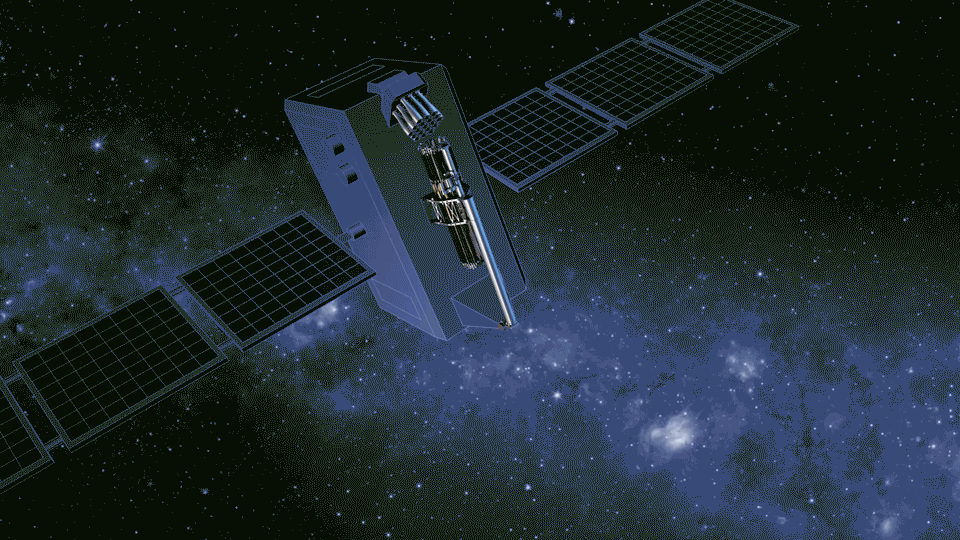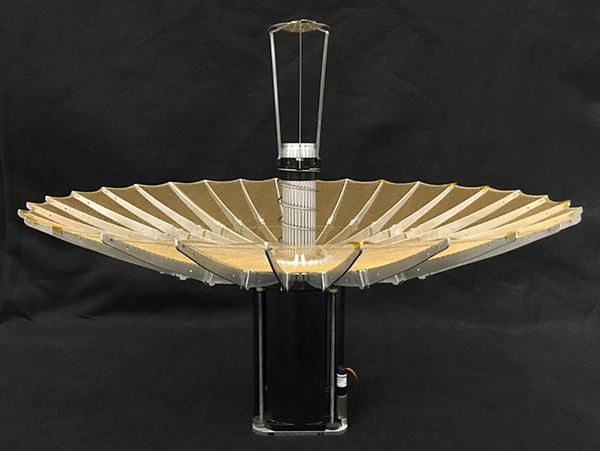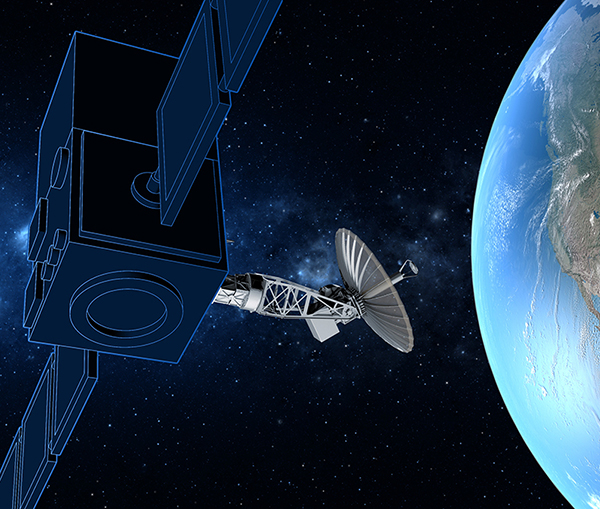
Unfurling Antennas Let Tiny Satellites Do Big Things
Subheadline
High-gain antennas for communication and imaging can now ride smaller, cheaper spacecraft
As NASA’s Artemis missions build out infrastructure on and around the Moon in the coming years, CubeSats and other small satellites will likely play an important role in a communications network that will enable not only conversation with mission control but also navigation, direct scientific observations, and more, all enabled by an internet-like “LunaNet.” These little satellites are cheap to launch and can form constellations for relaying signals reliably. But their small size makes it hard for them to carry antennas large enough to communicate across vast distances.
Now, a solution that was invented at NASA’s Jet Propulsion Laboratory in Southern California is already drastically reducing the cost of putting antennas for sensing and communications into Earth orbit. Satellite builders now have the option of using small, collapsible dish antennas made by Tendeg LLC of Louisville, Colorado, which developed them with funding and cooperation from NASA, along with the patented technology developed at JPL.
In 2014, JPL set out to build a high-gain, high-frequency antenna that could collapse into a canister only about four by six inches in size, with the goal of allowing a CubeSat to communicate with Earth from as far away as Martian orbit. The resulting Ka-Band Parabolic Deployable Antenna (KaPDA) had curved, folding ribs and a reflector dish of gold-coated metal mesh. A small motor extended the antenna’s central hub, which unfolded the rest of the structure by a series of catches, hinges, and springs.
Part of the challenge was that the antenna needed to handle higher frequencies than prior CubeSat antennas, said Jonathan Sauder, who was a KaPDA team member at JPL. Higher frequencies transmit data at a much higher rate. The KaPDA was to transmit in the Ka-band, microwave frequencies that would allow data rates 10,000 times those of even “high-performing” CubeSat antennas of the day. But these tiny waves require a much more perfect reflecting surface, said Sauder. “If you’re doing communication in the Ka-band, you need 0.3 millimeters of surface accuracy in order to focus the beam.”
The project exceeded expectations. At less than 20 inches across, KaPDA was smaller and performed better than anticipated. JPL patented the overall antenna design and tried it out in Earth orbit on a little satellite called RainCube, which went into orbit in the summer of 2018 and used radar to track heavy storms.
Meeting Industry Needs
From 2015 through 2020, Tendeg, whose founders had worked on deployable satellite instruments since the 1990s, received a series of Small Business Innovation Research (SBIR) contracts from JPL to develop a follow-up to RainCube. This design maintained Ka-band surface accuracy and the ability to deploy from a CubeSat but expanded the aperture to 40 inches and used a new deployment mechanism.
Throughout this time, Tendeg also won several other SBIR contracts from JPL to work on adapting metal mesh for Ka-band reflectors and to design small, deployable antennas and precise, deployable boom and hinge systems. The work led to a 2021 contract from JPL to build a 63-inch Ka-band reflector for a mission called INCUS, short for Investigation of Collective Updrafts.
The INCUS project led to a flight contract with a commercial company that’s already using the resulting antenna to collect Earth imagery with the synthetic aperture radar technique, which can penetrate clouds and darkness. That antenna has become one of Tendeg’s commercial products, known as KaTENna, which can be up to 11 feet across. At that size, though, it needs a satellite a little larger than a CubeSat.
As rideshares into orbit have become cheaper in the last few years, CubeSat popularity has fallen off in favor of slightly larger, less restrictive small satellites, said Gregg Freebury, Tendeg president and CEO. “One thing we’ve seen is, customers have come back and said, what we really need is a larger aperture because we need more gain,” Freebury said. “And then the other thing is, they often wanted these to be steerable so they would be able to track a ground station on Earth or perhaps track another satellite.”
To meet that second need, Tendeg secured an exclusive license to the KaPDA technology and redesigned it while incorporating many of the same elements as well as a gimbal, which gives the antenna a hemisphere of pointing motion. The resulting KaPDA Gimbal antenna has become one of the company’s most popular products, Freebury said. “Most of our growth right now is around this gimbal antenna system.”
He noted that all the company’s antenna designs, including a couple it hasn’t quite commercialized yet, benefit from both NASA SBIR funding and the KaPDA license. “Anytime we incorporate any of the KaPDA patent elements or some of the non-patented but technology-transferred elements, we pay royalties,” Freebury said. “We’re picking up a lot of steam on this, so we’re writing more checks and bigger checks to Caltech every quarter now.” (Caltech, or the California Institute of Technology, manages JPL and owns patents the lab generates.)
“This gimbal approach and its compactness could not happen without KaPDA,” said Mark Thomson, who is now Tendeg’s chief technology officer but conceived and oversaw KaPDA development during the 10 years he was a chief engineer at JPL. “It’s not pretty what you have to do to stow a gimballed 70-centimeter antenna if its dish doesn’t fold up like this.”
‘You Just Can’t Match It’
Only a couple of years after Tendeg was selected to build the INCUS antenna and licensed KaPDA, sales on the first two resulting commercial products are rolling in. A version of KaPDA Gimbal is already going up on the first satellites of one company’s planned communication constellation, Freebury said, noting that each of these satellites needs two or three of the antennas, and the company plans on a constellation of up to 200. “They’re operating at even higher frequencies, in the QV band,” he said. “So the combination they needed, of a higher-frequency deployable reflector and very precise pointing capability, no one else is able to do.”
Thomson noted that the KaPDA Gimbal offers an advantage even to makers of larger satellites. “Because it does fit a microsatellite, we can fold it up like a switchblade on the side of a larger spacecraft and really make a huge difference on size, weight, and power for gimbaled antennas using this design,” he said. “You just can’t match it with any other approach and have mechanical steering in two directions.”
Two other commercial customers are also under contract to buy KaPDA Gimbal antennas, and it and the KaTENna both have multiple customers who are federal defense contractors. In April of 2023, Lockheed Martin announced that Tendeg would be its new strategic supplier for deployable antennas.
The company has already grown to 90 employees and announced in October of 2023 that it would expand into a new 100,000-square-foot facility and planned to add up to 451 new jobs over the following eight years.
Freebury said all of the burgeoning company’s products were only made possible through its work with the space agency. “Especially the SBIR funding is pretty much what allowed us to do all the R&D that’s led to all of our antenna architectures,” he said.

The Jet Propulsion Laboratory developed the Ka-Band Parabolic Deployable Antenna (KaPDA) to enable high-speed communication with small satellites in deep space. Tendeg licensed the design and incorporated aspects of it into the company’s antennas. Credit: NASA

By late 2022, this gimbaled, steerable version of a redesigned KaPDA antenna had become one of Tendeg’s most popular products. Credit: Tendeg LLC

Tendeg’s Perimeter Truss Reflector incorporates various elements developed under NASA funding. The company expects this antenna, now in the study and testing phase, to become one of its best sellers. Credit: Tendeg LLC













